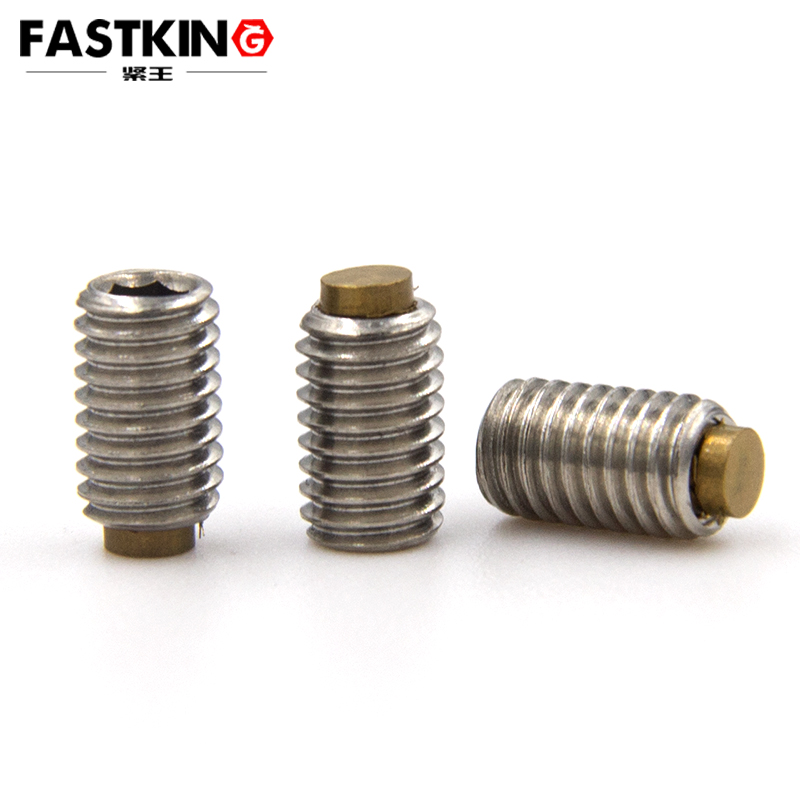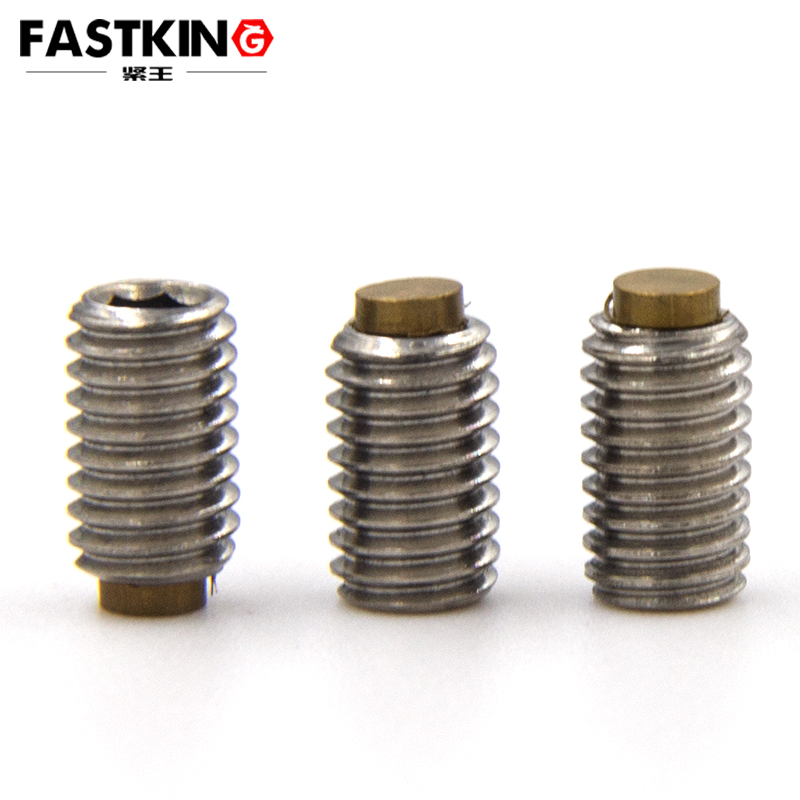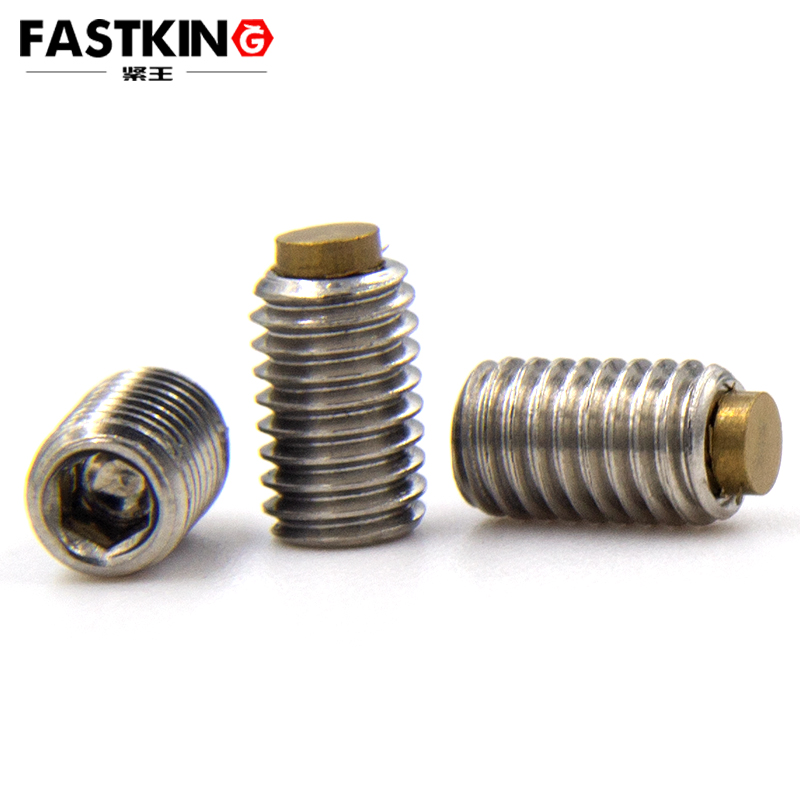Copper head set screws with a hex socket are specialized fasteners featuring a copper head, which offers excellent conductivity and corrosion resistance. The threaded portion is typically made of steel or stainless steel to ensure sufficient mechanical strength. The hex socket design allows for tightening and loosening using a hex key, making these screws suitable for applications requiring high precision and reliability.
1. Electronic and Electrical Equipment
Copper head set screws with a hex socket are commonly used in electronic and electrical equipment, particularly in scenarios requiring good conductivity and electromagnetic interference resistance. For example, they are used in securing circuit boards, connecting power modules, and assembling high-frequency devices. The copper head effectively reduces contact resistance, ensuring stable current transmission.

2. Precision Instruments
In precision instruments and equipment, copper head set screws with a hex socket are often used for connecting components that require high precision and stability. Examples include optical instruments, measuring devices, and laboratory equipment. These screws provide reliable clamping force while preventing precision loss due to material corrosion or loosening.
3. High-Temperature Environments
Copper head set screws with a hex socket perform exceptionally well in high-temperature environments, especially where heat and corrosion resistance are required. For instance, they are used in heat treatment equipment, high-temperature furnaces, and certain chemical processing equipment. These screws can withstand thermal expansion and chemical corrosion, ensuring long-term stable operation.
4. Corrosion-Resistant Applications
Due to copper's excellent corrosion resistance, copper head set screws with a hex socket are often used in humid or corrosive environments. Examples include marine equipment, ships, and certain chemical processing equipment. These screws effectively resist corrosion from seawater, acids, and alkalis, extending the equipment's service life.
5. High-Conductivity Applications
Copper head set screws with a hex socket are also widely used in applications requiring high conductivity. Examples include power equipment, battery connections, and certain high-frequency circuits. These screws ensure stable current transmission and reduce energy loss.

Usage Methods
1. Selecting the Appropriate Screw Specifications
Before using copper head set screws with a hex socket, it is essential to select the appropriate specifications based on the application. This includes the screw's diameter, length, and thread type. Ensure that the screw's dimensions and strength meet the requirements of the connected components.
2. Preparing the Tools
Copper head set screws with a hex socket require a hex key for installation and removal. Therefore, ensure that a hex key of the correct size is prepared before use. The key must match the screw's hex socket to avoid damaging the screw head.
3. Cleaning the Connection Surface
Before installing the screw, ensure that the connection surface is clean and free of debris. This is particularly important for applications requiring high conductivity or precision, as surface cleanliness directly affects the screw's clamping effectiveness and conductivity. Use a cleaning agent or alcohol to wipe the surface, removing oil and dust.
4. Proper Installation
Insert the copper head set screw into the connection hole and tighten it clockwise using a hex key. During tightening, apply even force to avoid over-tightening, which could strip the threads or damage the connected components. For high-precision applications, use a torque wrench to tighten the screw to the specified torque value, ensuring proper clamping force.
5. Regular Inspection and Maintenance
During use, especially in high-temperature, humid, or corrosive environments, regularly inspect and maintain the screws. Check for signs of loosening, corrosion, or damage, and tighten or replace the screws as necessary. For high-conductivity applications, also regularly check the screw's conductivity to ensure stable current transmission.

6. Removal Methods
When removing a copper head set screw with a hex socket, use a hex key to turn it counterclockwise and gradually loosen it. During removal, take care to avoid damaging the screw head or connected components. If the screw is difficult to remove due to corrosion or prolonged use, apply an appropriate lubricant or use heating methods to help loosen it.
Precautions
1. Avoid Over-Tightening
When installing copper head set screws with a hex socket, avoid over-tightening. Over-tightening can strip the threads, deform or damage the connected components, and affect the equipment's normal operation. This is especially critical in precision instruments and high-precision equipment, where over-tightening can lead to precision loss.
2. Prevent Electrochemical Corrosion
Although copper has excellent corrosion resistance, electrochemical corrosion may occur when copper comes into contact with other metals. Therefore, when using copper head set screws with a hex socket, avoid direct contact with dissimilar metals or use appropriate isolation measures to prevent electrochemical corrosion.
3. Selecting the Right Lubricant
In high-temperature or corrosive environments, use an appropriate lubricant to protect the screws and extend their service life. However, ensure that the lubricant is compatible with copper to avoid chemical reactions that could corrode the material.
. Conclusion
Copper head set screws with a hex socket are widely used in electronic and electrical equipment, precision instruments, high-temperature environments, corrosion-resistant applications, and high-conductivity scenarios due to their excellent conductivity, corrosion resistance, and precision. During use, select the appropriate screw specifications, install and remove them correctly, and perform regular inspections and maintenance to ensure reliability and long-term stable operation of the equipment. With proper use and maintenance, copper head set screws with a hex socket provide a reliable fastening solution for various high-demand applications.
